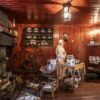Gerard Hall was built in 1882 as a church hall and is named after Rev. Dr. James Gerard Young who was minister for more than 25 years.
- What's On
-
Things to See & Do

Browse By Category
Highlights
-
Plan Your Trip

Browse By Category
Highlights
-
Get Inspired

Browse By Category
















